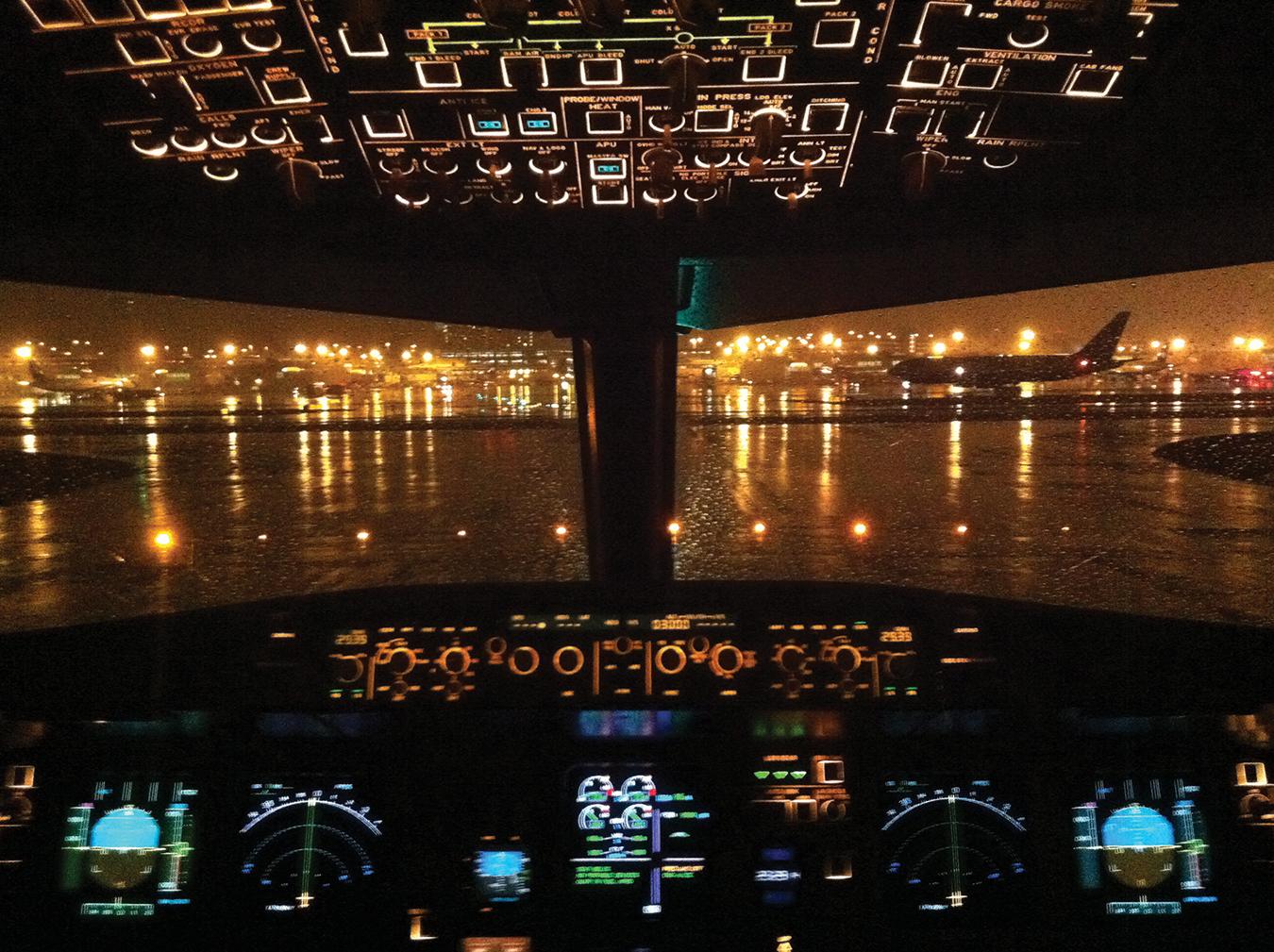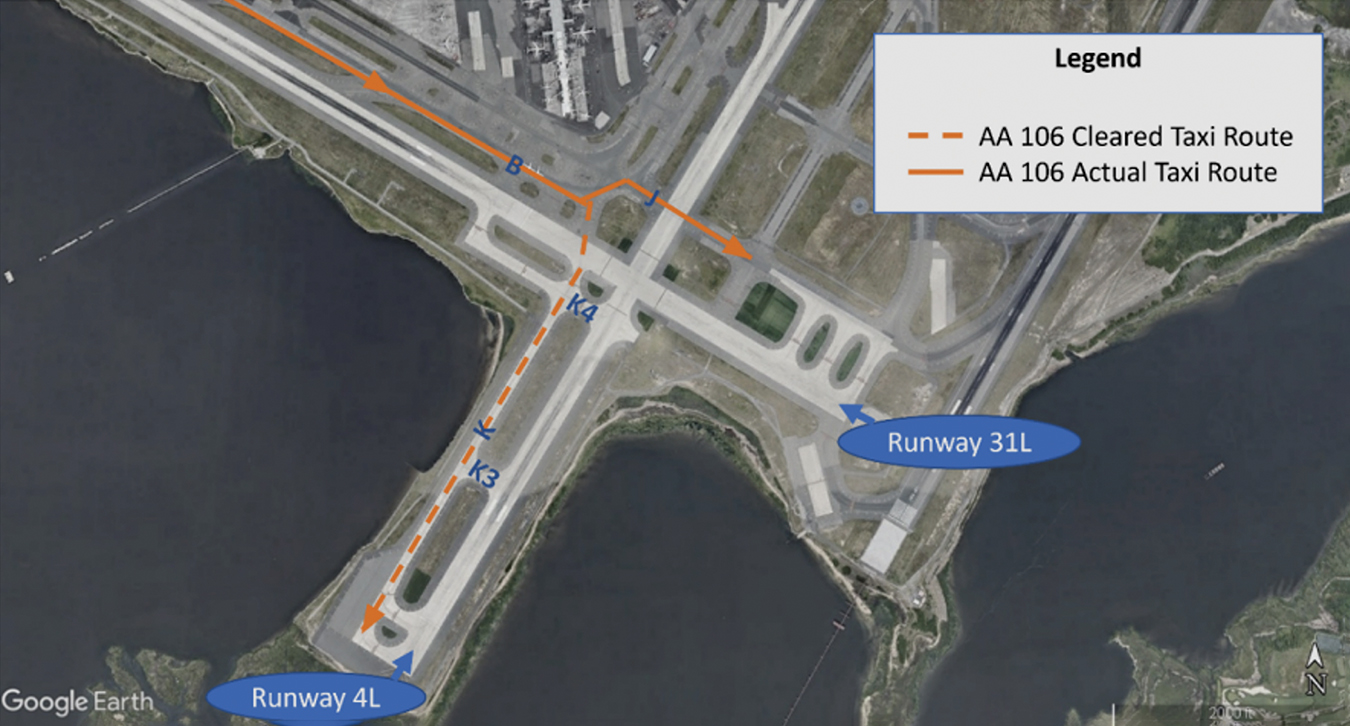
An airplane holding short of a runway, seen from the cockpit.
Recently, I co-moderated the plenary session of the FAA’s Safety Summit with FAA Acting Administrator, Billy Nolen. In case you’ve been living on Mars for the past few months, there have been several recent, highly publicized safety-related events affecting the U.S. commercial aviation system. The FAA issued a Safety Alert for Operators on March 22, stating that “the potential severity of these events is concerning.”
In December, a United Airlines Boeing 777 flight plunged to within 800 ft. of the Pacific Ocean after departing Maui. The aircraft climbed to 2,200 ft. after takeoff and then began descending toward the water at more than 8,000 fpm. That same day, 36 people were injured in turbulence on a Hawaiian Airlines flight from Phoenix to Honolulu. Eleven of those injuries were serious. Later that month, a ramp agent died when she was ingested into an engine of an Embraer 170 at Montgomery, Alabama.
In early March, a Bombardier Challenger 300 was involved in an inflight upset. A 55-year-old old passenger died following a series of extreme pitch oscillations and severe G-forces. The Part 91 flight departed Keene, New Hampshire, and was en route to Leesburg, Virginia, when the upset occurred. Details have yet to emerge on the cause of the upset, but what is troubling is what happened before the aircraft even left the ground. The first departure attempt ended in a rejected takeoff (RTO), when one of the pilots noticed a disagreement between the captain’s and first officer’s airspeed indicators. This wasn’t a disagreement of just a few knots: According to NTSB’s preliminary report, at the time of the RTO, the captain’s primary flight display (PFD) indicated 104 kt., while the FO’s PFD displayed only 2 kt. A question yet to be answered is why this disagreement was not called out and the RTO initiated before reaching 104 kt.
The airplane was taxied clear of the runway and onto a taxiway. The left engine was shut down, and air stairs were lowered. The second-in-command deplaned, walked to the front of the airplane and discovered that the right pitot probe cover was still in place. He removed the cover, noticed no damage, and returned to the cockpit. The left engine was restarted and off they went for another takeoff. On takeoff roll, the second-in-command realized there were no V-speeds displayed on the PFD. He called out V1 and rotate at 116 kt., based on his memory of previous takeoffs. To be clear, these events may have had nothing to do with the cause of the upset, but it does call into question the crew’s attention to detail before things really turned sour.
What has received the most attention over the past few months is the slew of highly publicized runway incursions, including two in which pilots took off without ATC clearance. During the first two-and-a-half months of this year, there have been at least six of the most severe categories of runway incursions, compared to a 20-year average of around two-and-a-half per year.
An easy explanation—one that I’ve heard several times over the past few weeks—is that the aviation industry is coming out of the pandemic and the workforce is a bit rusty. I don’t buy it. The pilot workforce has been in a massive hiring mode for over a year now. Which pilot needs a year to wipe the rust off? Besides, what data do we have that shows that these events are related to “rusty” pilots and controllers?
A common thread woven throughout several of these events appears to be a lack of attention to detail. As in taking off without clearance. Crossing runways without clearance. Failing to remove a pitot cover. It’s time to get refocused and get back to basics—basics like avoiding distractions during critical phases of taxi and flight. Basics such as the crew carefully monitoring and cross-checking each other while taxiing. Basics like ensuring that everyone on the flight deck understands and agrees on taxi instructions and ATC clearances, and basics like ensuring those instructions are followed. The FAA’s Safety Alert for Operators indicated that these recent events “demonstrate the need for continued vigilance and attention to mitigation of safety events.” Within the past few days, the Air Line Pilots Association International issued a safety alert to “maintain and increase vigilance, actively prevent complacency, and continually report hazards.”
Of the six or so runway incursions since January, only two of them—those at Austin, Texas and Sarasota, Florida—involved air traffic controllers trying to “push tin” too closely. In each instance, an air traffic controller issued takeoff clearance while another aircraft was on a close final to the runway. The five remaining runway incursions were pilot-related.
There are two pilots on the flight deck for a reason. Having two sets of eyes and ears is one of the most effective safety measures in the cockpit. When I first arrived at a business aviation flight department years ago, it wasn’t unusual to have one pilot starting the engines and calling ATC for taxi instructions while the other pilot was still in the back briefing passengers. Similarly, during my airline career, there were times when I was talking to the ground crew on the interphone while the first officer was calling for taxi. Doing these things may save scant seconds of time, but they also circumvent the critically important redundancy of having two pilots listening to, understanding, and agreeing on the taxi instructions.

In mid-January, an American Airlines Boeing 777 bound for London Heathrow Airport entered Runway 4L at John F. Kennedy International Airport and proceeded across the runway on Taxiway Juliet without ATC authorization. As the 777 entered the runway, a Delta Air Lines Boeing 737, having received ATC clearance for takeoff, was accelerating through 80 kt. on Runway 4L. The two aircraft were approximately 2,700 ft. apart at this point. The Delta crew initiated a rejected takeoff at around 100 kt. and stopped the aircraft approximately 500 ft. from where the triple-seven had crossed on Juliet. Because the 777 had continued across while Delta was decelerating, the closest the two aircraft came to each other was about 1,400 ft., according to NTSB.
Some runway incursions are the result of an aircraft failing to stop and blundering onto a runway without clearance. This wasn’t one of them. American was instructed to taxi to Runway 4L via taxiway Bravo. At some point during taxi, the crew was cleared to cross runway 31L at Taxiway Kilo. However, upon reaching the Taxiway Bravo/Taxiway Kilo intersection, the aircraft made a left turn, followed by a quick 90-deg. right turn onto Taxiway Juliet and continued across Runway 4L without ATC clearance.
One factor in runway incursions is pilots not having a clear understanding of taxi instructions or having an erroneous pre-conceived mindset of what the plan will be. In the JFK case, the most typical departure runway for heavy jets is Runway 31L. It’s plausible that with that mindset, the captain erroneously proceeded as if 31L was the designated departure runway.
It’s understandable that the erroneous mindset of one person could lead to this error, but there were two other pilots on the flight deck that evening—the first officer and an international relief officer. Where was the redundancy and crosscheck from those pilots?
There are also procedures designed to enhance crew vigilance during taxi. American Airlines’ procedure specifies that the crew should review the planned departure runway, as well as the planned taxi route, including hot spots and runway crossings. Several years ago, I was part of a group that revised the FAA’s advisory circular on flight crew procedures during taxi operations. Although the version that we created has since been updated by FAA Advisory Circular AC 120-74B, both versions specify an important best practice: “Brief the expected taxi route to include any hold-short lines and runways to cross, hot spots, and any other potential conflicts. Once taxi instructions are received, the pre-taxi route should be reviewed and monitored. It is essential that any changes to the taxi route be understood by all crewmembers.”
The first accident I investigated with the NTSB was the wrong-runway departure of Comair Flight 5191. As readers may recall, the crew taxied to and attempted to take off on a runway that was too short. The airplane overran the runway, crashed into trees, and burst into flames. Forty-nine lives were lost in the pre-dawn hours that August day. NTSB noted that the crew failed to conduct a thorough taxi briefing, as required by Comair standard operating procedures. We determined that had a complete taxi briefing been done, the crew would have had greater awareness that a shorter runway—the one that they unsuccessfully attempted to depart on —intersected their intended taxi route to the correct runway.
Although a pre-taxi briefing can help prevent runway incursions, there is also a potential downside—such a briefing could set an expectation bias for the anticipated taxi route. AC (advisory circular) 120-74B lays out this potential problem: “Caution: A potential pitfall of pre-taxi and pre-landing planning is setting expectations and then receiving different instructions from ATC. Flight crews need to follow the clearance or instructions that are actually received, and not the ones they expected to receive.”
Critical flight deck redundancy can be lost when pilots attempt to do the right things at wrong time. There are activities that need to be done before takeoff, such as loading the flight management computer and going through a checklist. Likewise, after landing, one pilot often is off the ATC frequency and calling the FBO or operations. Although these things may be necessary, a sharp pilot will choose when and where to do them, considering the importance of doing them during the lowest-risk periods.
Review of incidents and accidents reveal that we are more vulnerable to missing things when one pilot is heads-down, off ATC frequency, or otherwise out of the loop. In 2013, the Flight Safety Foundation published A Practical Guide for Improving Flight Path Monitoring. The document defined Areas of Vulnerability (AOV) as those areas of operation where there is an “increased likelihood of a flight path [or taxi] deviation or the increased severity of potential consequences if such a deviation occurs.” Because approaching an active runway is considered a high AOV, a good prioritization of tasks may be for both pilots to suspend doing everything other than making sure the aircraft stops short of the runway, or, if it is about to cross, both pilots agree and confirm clearance to cross.
Another vulnerability occurs when pilots do the wrong things at the wrong time. Avoiding distractions by complying with the sterile cockpit rule is strong defense against runway incursions and other safety problems. As NTSB noted in the Comair wrong runway departure crash, there was constant non-pertinent chatter during taxi, which “likely contributed to their loss of positional awareness.”
We all make mistakes–I’ve certainly made more than a few myself. However, a combination of flight crew vigilance, attention to detail, and SOP compliance can help minimize errors, or when one is made, neutralize the error before it leads to something serious. Add to that list the need to refocus and get back to basics.





